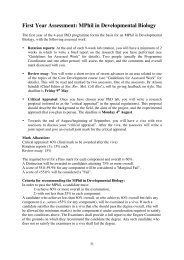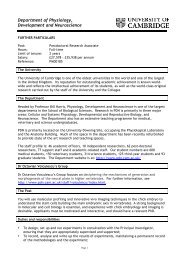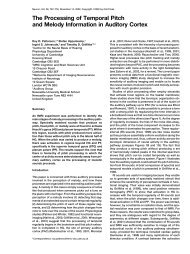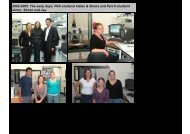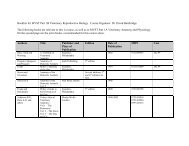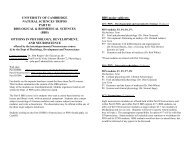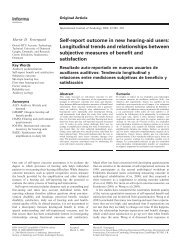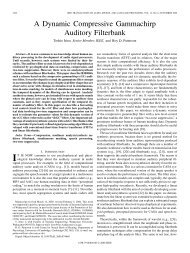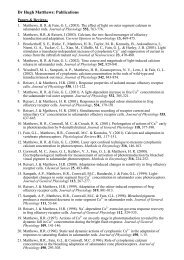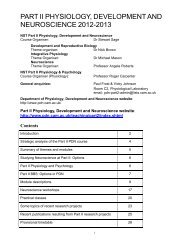FRIDAY MORNING, 20 MAY 2005 REGENCY E, 8:30 A.M. TO 12:00 ...
FRIDAY MORNING, 20 MAY 2005 REGENCY E, 8:30 A.M. TO 12:00 ...
FRIDAY MORNING, 20 MAY 2005 REGENCY E, 8:30 A.M. TO 12:00 ...
Create successful ePaper yourself
Turn your PDF publications into a flip-book with our unique Google optimized e-Paper software.
11:<strong>30</strong><br />
5aSA10. Vibration control of optomechanical components.<br />
Vyacheslav M. Ryaboy Newport Corp., 1791 Deere Ave., Irvine, CA,<br />
92606, vyacheslav.ryaboy@newport.com<br />
The purpose of optomechanical components is to anchor optical elements<br />
such as light sources, lenses, mirrors, etc. in space so that the<br />
optical paths would be unperturbed by environmental impacts, first of all<br />
by vibration. Dynamic alignment of components is a main design optimization<br />
criterion for the optomechanical systems. An optical table or breadboard<br />
is often used as a common base for the whole optomechanical<br />
assembly. It can be sufficiently isolated from the floor vibration, but its<br />
own flexural resonance vibrations may still cause misalignments. The paper<br />
estimates various ways of vibration damping of optical tables, including<br />
new methods of passive damping combined with motion transformation,<br />
as well as active damping. Optical rods and posts offset optical<br />
elements from the table. These components have their own resonance<br />
properties. The paper presents analytical estimates and optimization methods<br />
for introducing damping materials in the optical posts. Experimental<br />
results comparing dynamic properties of damped and non-damped structures<br />
will be presented.<br />
11:45<br />
5aSA11. Whole body vibration measurements on forklift trucks.<br />
Alberto Behar Noise Control, 45 Meadowcliffe Dr, Scarborough, ON,<br />
Canada, M1M 2X8 behar@sympatico.ca and Steven Libich WESA<br />
Data on acceleration values on forklift trucks related to Whole Body<br />
Vibration are notably missing in the literature. Although there are several<br />
standards that provide guidance on how measurements have to be performed,<br />
they are somehow conflicting and difficult to implement since<br />
they require simultaneous measurement and processing of data in the three<br />
axes, x, y and z. Standards also provide limit values for safety of the<br />
personnel exposed to the vibrations. The development of new instruments<br />
has made these kind of measurements much easier to perform and to<br />
interpret the results, since they include filters following the standards and<br />
allow for the use of tri-axial accelerometers. This paper describes measurements<br />
done on 11 forklift trucks in a real-life situation, while performing<br />
tasks normal for their use. The trucks are of the standing-operator type.<br />
The accelerometers were mounted on the body of the truck, so that vibrations<br />
were representative for what the operators were exposed to. The<br />
three-axes orientation of the accelerometer were taken into account. The<br />
paper will present results of the measurements and their assessment following<br />
the existing ISO and BS Standards.<br />
<strong>FRIDAY</strong> <strong>MORNING</strong>, <strong>20</strong> <strong>MAY</strong> <strong>20</strong>05<br />
<strong>REGENCY</strong> D, 8:<strong>00</strong> A.M. <strong>TO</strong> <strong>12</strong>:<strong>00</strong> NOON<br />
Session 5aSC<br />
Speech Communication: Intelligibility and Studies of Populations with Speech and Hearing Disorders<br />
„Poster Session…<br />
Sigfrid D. Soli, Chair<br />
House Ear Inst., 21<strong>00</strong> W. Third St., Los Angeles, CA 9<strong>00</strong>57<br />
Contributed Papers<br />
All posters will be on display from 8:<strong>00</strong> a.m. to <strong>12</strong>:<strong>00</strong> noon. To allow contributors an opportunity to see other posters, contributors of<br />
odd-numbered papers will be at their posters from 8:<strong>00</strong> a.m. to 10:<strong>00</strong> a.m. and contributors of even-numbered papers will be at their<br />
posters from 10:<strong>00</strong> a.m. to <strong>12</strong>:<strong>00</strong> noon.<br />
5aSC1. Evaluation of effect of presbycusis on speech intelligibility by<br />
several kinds of speech test in rooms. Hiroshi Sato Inst. for Human<br />
Sci. & Biomed. Eng., Natl. Inst. of Adv. Industrial Sci. and Technol., 1-1-1<br />
Higashi, Tsukuba, Japan and Hayato Sato Kobe Univ., Rokko, Nad,<br />
Kobe 657-8501, Japan<br />
Word recognition tests with logatom and word familiarity controlled<br />
word lists and sentence intelligibility test in simulated sound fields with<br />
noise and/or reverberation were carried out to assess the effect of hearing<br />
loss due to aging on speech communication in rooms. The result demonstrates<br />
that 1 speech recognition scores of elderly listeners are 25%<br />
lower than those of young adults for any kinds of speech test. This difference<br />
is equal to the 5 dB increase of ambient noise for elderly listeners. 2<br />
Detailed speech recognition process in noise and/or reverberation is described<br />
with scores of various kinds of speech test. 3 Peripheral auditory<br />
functions are mainly affected by aging. On the other hand, central auditory<br />
processing functions of the aged examined with word familiarity and<br />
meanings of words shows same performance as the young. These results<br />
were expected to lead the discussion for speech communication in aged<br />
society and the standardization for sound environment.<br />
5aSC2. Effect of training using lexically easy and hard words on<br />
speech understanding in noise. Matthew H. Burk and Larry E. Humes<br />
Dept. of Speech and Hearing Sci., Indiana Univ., Bloomington, IN 47405,<br />
maburk@indiana.edu<br />
Older hearing-impaired adults often have difficulty understanding<br />
speech in noise, even with proper amplification. One reason for this difficulty<br />
may be a lack of practice or inability to make use of new auditory<br />
information, which has been absent due to a progressive, peripheral hearing<br />
loss over many years. An often overlooked aspect of the rehabilitation<br />
process, which could help to improve this deficit, is listener training. The<br />
goal of this study was to create a word-based training protocol which<br />
could improve speech understanding in noise when listeners are presented<br />
with new, novel stimuli outside the clinic. Previous work with word-based<br />
training using one talker showed a large training effect that generalized to<br />
novel talkers; however, sufficient generalization to novel words and sentences<br />
was lacking. The current study attempts to increase generalization<br />
by training listeners with multiple talkers and lexically hard words. Generalization<br />
to novel words, both lexically easy and lexically hard, novel<br />
talkers, and sentences, with the latter also constructed from lexically easy<br />
5a FRI. AM<br />
2603 J. Acoust. Soc. Am., Vol. 117, No. 4, Pt. 2, April <strong>20</strong>05 149th Meeting: Acoustical Society of America 2603



